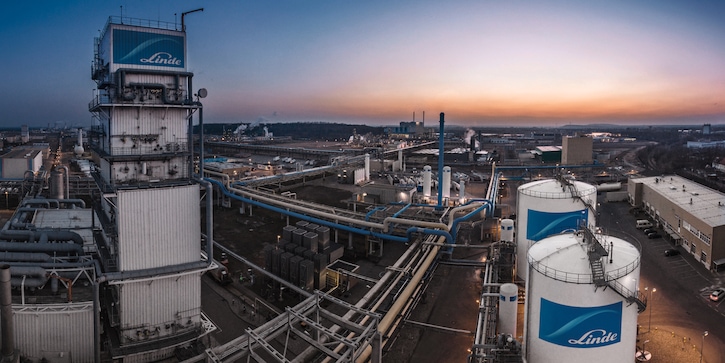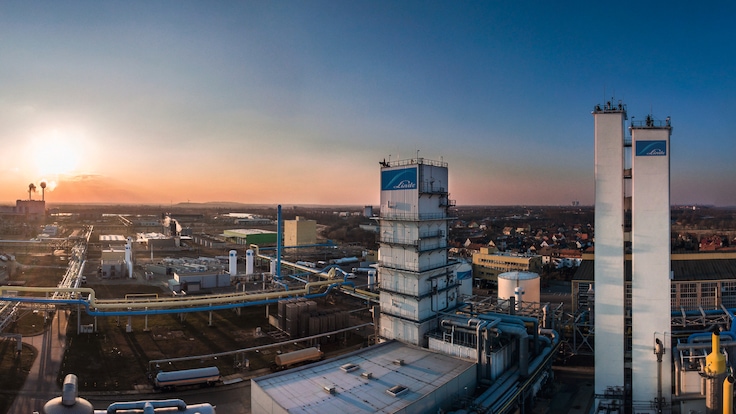LINDE PLANTSERV ASU Energy Benchmark

Type in the values of the production case you want to analyze.
Asset Health ChecksWith a new online tool, the LINDE PLANTSERV® ASU Energy Benchmark, operators of air separation plants can now quickly explore optimization potential and optimize maintenance planning.

LINDE PLANTSERV adapts industrial plant to new production specifications
Operators of the air separation plant in the Czech municipality of Vresova needed to change course – prompted by a drop in market demand for gaseous oxygen coupled with a simultaneous uptick in demand for argon. As is often the case in the air separation business, they were challenged to adapt their operations to a shift in the economic climate. This can impact demand among downstream industries for product volumes and – in some instances – even for product compositions. These new requirements mean that processes have to be adapted and the plant has to be modified – in some cases quite extensively. The biggest challenge for operators is to ensure a smooth and – even more importantly – efficient, cost-effective transition.
“With the help of a new online tool, the LINDE PLANTSERV ASU Energy Benchmark, operators of air separation plants can now quickly explore optimization potential, compare against best practice and optimize maintenance planning.”

This is where LINDE PLANTSERV experts come in. As one of their core competencies, their job is to adapt industrial plants to changing boundary conditions and optimize operations. One of their recent projects was the re-purposing of an air separation plant in Vresova. Until now, its main mission was to produce gaseous oxygen for a nearby IGCC (Integrated Gasification Combined Cycle) plant. The plant no longer needed gaseous oxygen, however. LINDE PLANTSERV expert Dirk Schwenk and his team asked themselves how an air separation plant that had only been built some 15 years ago could be optimized to efficiently support new operating conditions and a new product mix. “There is no longer a need for gaseous oxygen, but there is plenty of demand for liquid oxygen and liquid nitrogen, which are delivered to customers by tanker trucks. Another product that is gaining traction is argon. Market demand for this noble gas is extremely high,” explains Schwenk. The main focus for the Linde engineer and his team was therefore to present options for adapting the air separation plant to the new boundary conditions with minimum investment so it could continue to be operated efficiently in future.
The LINDE PLANTSERV experts started with a detailed asset health check before developing modification proposals. This included dropping the operating pressure by several bar at a key operating point to reduce the need for air compressors. Based on this new pressure level, the team then checked whether the process flow would still function safely and reliably. This entailed taking a close look at all key components, including the heat exchanger, compressor, turbine, pump and critical valves.
The team evaluated six different modification paths, benchmarking them to compare cost, savings, ROI, safety performance and feasibility. As Schwenk points out, the plant specialists were well aware that “the volume of argon produced depends heavily on the process parameters, in other words the way the plant is operated. The production volume of argon can fluctuate enormously, ranging between 50 and 90 percent.” Around one percent of the air is composed of argon. Nitrogen and oxygen account for the lion’s share at around 80 and 20 percent respectively. Simply pumping more air into the plant would not be productive, however, as that would also increase the oxygen yield along with the energy costs required to compress and liquefy it – and a higher oxygen yield was not the aim. For Schwenk, the main challenge lies in “fine-tuning the process parameters in order to maximize the argon yield while minimizing the energy bill”. So, for instance, the LINDE PLANTSERV experts discovered that a drop in pressure could reduce compression requirements and thus energy costs – without requiring any equipment investments other than a new pipe.
“The LINDE PLANTSERV experts discovered that a drop in pressure could reduce compression requirements and thus energy costs – without requiring any equipment investments other than a new pipe.”

Reaching beyond the technical hurdles inherent in projects such as these, the LINDE PLANTSERV experts also need to overcome any uncertainties or doubts expressed by the customer. “It goes without saying that reliable, routine operations is the top priority. Our customers want operational stability so it is natural that they would have reservations about the potential impact of new boundary conditions on their asset performance,” admits Schwenk. “This makes it all the more important to be able to put ourselves in our customers’ shoes and bring the necessary awareness and understanding to the table. Thanks to our unique and long-standing experience with industrial plants and equipment, we can give our customers all the assurances they need.” After all, Linde Engineering has built over 4,000 plants around the world, many of which are operated by Linde Gas. This know-how and bundled expertise give LINDE PLANTSERV unique insights into the operation and maintenance of plants. Customers benefit not only from a wide range of value-add services, but also from the peace of mind and trust that comes from teaming up with an experienced partner.
The LINDE PLANTSERV team is expert at assessing how process plants will react to different operating conditions and whether the necessary changes can be implemented reliably and safely. Maximizing asset availability and maintaining asset health is the ultimate aim. This also involves making plant operators aware of the importance of maintenance as process equipment has to be in good health for the plant to run efficiently overall. In other words, operators need advance notice of upcoming maintenance works so they can carve out an optimal slot in the tightly planned production schedule. Linde developed the LINDE PLANTSERV ASU Energy Benchmark tool to give air separation plant operators rapid insights into asset health. An easy-to-use Web interface allows customers to enter various key parameters such as energy consumption, production volumes of liquid and gaseous products, and pressure details. An algorithm uses up to 14 parameters specified by the customer to determine the status of the plant, and a traffic light system tells the operator at a glance whether asset maintenance is advisable or not.
“LINDE PLANTSERV is an invaluable addition to the local Linde Gas operating team, helping us to master significant changes in operating conditions – such as the ones we faced with the ASU Vresova project. This bundled expertise will no doubt increasingly come into play as Europe steps up to the decarbonization challenge.”
The LINDE PLANTSERV team sees its mission as getting the best out of a plant while making sure it has been fine-tuned for its new role. Linde engineer Schwenk likes to compare the task with that of an orchestra conductor: “It’s like working with a bunch of different musicians – in our case plant experts, operators and customers. The plant equipment is like the instruments. Our job is to bring it all together in perfect harmony so we have a plant that runs smoothly and efficiently.” This entails aligning a huge bandwidth of skills. The key to success lies in maintaining a holistic view, properly assessing the abilities of the players and their instruments, getting the pitch and tone right, and skillfully setting the right tempo. Which is exactly what the LINDE PLANTSERV team did at the air separation plant in Vresova.
Looking at the wider cooperation between Linde Gas and LINDE PLANTSERV, Jiri Fridrich, Remote Operating Center (ROC) Performance Engineer, had the following to say: “LINDE PLANTSERV is an invaluable addition to the local Linde Gas operating team, helping us to master significant changes in operating conditions – such as the ones we faced with the ASU Vresova project. This bundled expertise will no doubt increasingly come into play as Europe steps up to the decarbonization challenge.”

Type in the values of the production case you want to analyze.
Asset Health Checks
Successful execution of more than 3,000 ASUs around the globe – including some of the world’s largest and most challenging multi-train plants.
Air Separation Plants